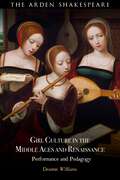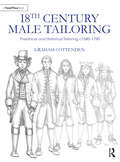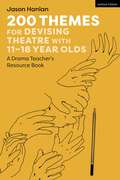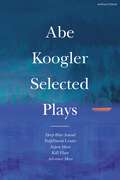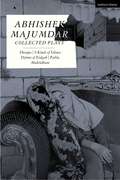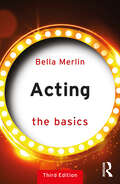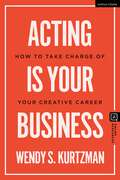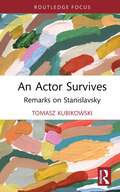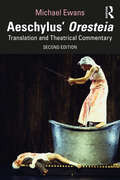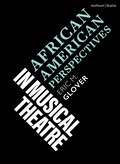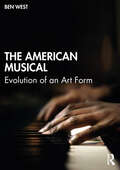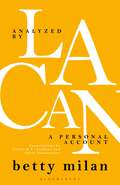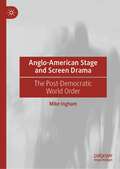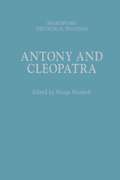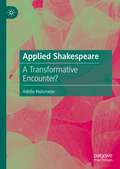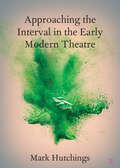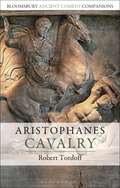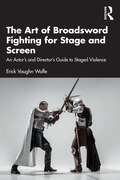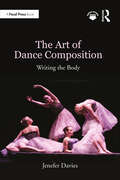- Table View
- List View
Girl Culture in the Middle Ages and Renaissance: Performance and Pedagogy
by Deanne WilliamsDeanne Williams offers the very first study of the medieval and early modern girl actor. Whereas previous histories of the actress begin with the Restoration, this book demonstrates that the girl is actually a well-documented category of performer and a key participant in the drama of the Middle Ages and Renaissance. It explores evidence of the girl actor in archival records of payment, eyewitness accounts, stage directions, paintings, and in the plays and masques that were explicitly composed for girls, and, in some cases, by them.Contradicting previous scholarly assumptions about the early modern stage as male-dominated, this evidence reveals girls' participation in medieval religious drama, Tudor civic pageants and royal entries, Elizabethan country house entertainments, and Stuart court and household masques. This book situates its historical study of the girl actor within the wider contexts of 'girl culture', including girls as singers, translators and authors. By examining the impact of the girl actor on constructions of girlhood in the work of Shakespeare – whose girl characters register and evoke the power of the performing girl – Girl Culture in the Middle Ages and Renaissance argues that girls' dramatic, musical and literary performances actively shaped medieval and early modern culture. It shows how the active presence and participation of girls shaped medieval and Renaissance culture, and it reveals how some of its best-known literary and dramatic texts address, represent, and reflect upon girl children, not as an imagined ideal, but as a lived reality.
18th Century Male Tailoring: Theatrical and Historical Tailoring c1680 – 1790
by Graham Cottenden18th Century Male Tailoring: Theatrical and Historical Tailoring c1680 – 1790 introduces the reader to English eighteenth-century tailoring and covers the drafting of patterns, cutting out in cloth and construction techniques in sequence for the tailoring of waistcoats, breeches and coats. From choosing the right cloth to preparing for the fitting process, this how-to guide will help readers create beautiful, historically accurate eighteenth-century male garments for events and performances. The book contains the following: step-by-step instructions complete with illustrations for students and costumiers who are new to the making of male tailored garments from the eighteenth century; drafting blocks and construction techniques for the different styles through the eighteenth century and patterns, photographs, detailed measurements and articles taken from a variety of male coats, waistcoats and trousers from c1680 – c1790 from museums and collections. 18th Century Male Tailoring is written for costume design and construction students, fashion students and practitioners who have a reasonable working knowledge of sewing and general costume making, but not necessarily of tailoring, drafting patterns, cutting skills and the making of male garments.
18th Century Male Tailoring: Theatrical and Historical Tailoring c1680 – 1790
by Graham Cottenden18th Century Male Tailoring: Theatrical and Historical Tailoring c1680 – 1790 introduces the reader to English eighteenth-century tailoring and covers the drafting of patterns, cutting out in cloth and construction techniques in sequence for the tailoring of waistcoats, breeches and coats. From choosing the right cloth to preparing for the fitting process, this how-to guide will help readers create beautiful, historically accurate eighteenth-century male garments for events and performances. The book contains the following: step-by-step instructions complete with illustrations for students and costumiers who are new to the making of male tailored garments from the eighteenth century; drafting blocks and construction techniques for the different styles through the eighteenth century and patterns, photographs, detailed measurements and articles taken from a variety of male coats, waistcoats and trousers from c1680 – c1790 from museums and collections. 18th Century Male Tailoring is written for costume design and construction students, fashion students and practitioners who have a reasonable working knowledge of sewing and general costume making, but not necessarily of tailoring, drafting patterns, cutting skills and the making of male garments.
200 Themes for Devising Theatre with 11–18 Year Olds: A Drama Teacher’s Resource Book
by Jason HanlanA unique resource for drama teachers providing 200 stimuli and age-appropriate individual topics within those to help inspire and guide young people in devising performance. It contains useful information on devising techniques, workshops, schemes and lesson ideas for introducing devising and guidance on how to analyse the work and give feedback.Following on from his successful book 200 Plays for GCSE and A-Level Performance, author Jason Hanlan has once again solved one of drama teachers' most frequently encountered problems: how to unlock the best devised performance with their students.Devising as a group requires a level of collaboration, which - without a strong framework - often descends into wild flights of fancy and a myriad of dead ends. Excellent ideas can be lost or diluted in an often-awkward attempt to tie it all together to fit a narrative.The main body of this book is a unique numbered listing of 200 stimuli, designed to both inspire and focus the mind, with an example of a possible topic and 'ways in' that would be suitable for each level:"Civil rights"> "Votes for women" (11 - 14 year olds)> "Rosa Parks" (14-16 year olds)> "The Disappeared" (16 - 18 year olds)Each stimuli is given its own page dedicated to exploring its possibilities as a piece of devised theatre for different age groups, and offering suggestions for plays, films and books to look at; artefacts and images to examine; ideas to consider; and further research you can draw on.
Abe Koogler Selected Plays (Methuen Drama Play Collections)
by Abe Koogler“Koogler's characters are earnest, idiosyncratic, and suspicious of hierarchy. Often bitingly funny, Koogler's plays…reveal larger truths about the economic and racial systems under which we all live.” (The Yale Review)Abe Koogler writes darkly comedic plays about ordinary Americans confronting larger political and economic forces, from small town residents grappling with environmental change to slaughterhouse workers trying to retain their humanity. Although grounded in realism, Koogler's plays often incorporate imaginary elements and heightened or musical language, creating moving and memorable works of art.In his first play collection, Koogler's work is brought together and introduced by the author, offering an overview of his range in style, from the naturalistic to the absurd.Deep Blue Sound: “If anything links all of these people, it is an aching loneliness. That they are trying to figure out what happened to orcas, which are remarkably social animals, is among the nice touches that Koogler has sneaked into his group portrait.” (New York Times)Fulfillment Center: “steeped in a luminous and illuminating empathy that feels both uncommon and essential right now.” (New York Times)Aspen Ideas: A fast-paced and darkly comedic thriller about an annual conference of the famous and well-connected, held high in the Colorado mountains.Kill Floor: “Melancholy and moving. A very closely, and often quite beautifully, observed character study.” (Chicago Tribune)Advance Man: Ripe with experimental language, movement and absurdism, a surprising comedy exploring what it means to be a politically engaged American.
Abhishek Majumdar Collected Plays: Dweepa; Pah-La; Djinns of Eidgah; Muktidham; 9 Kinds of Silence (Methuen Drama Play Collections)
by Abhishek MajumdarIn his first play collection published in English, international audiences can finally discover the acclaimed work of Abhishek Majumdar. Internationally celebrated author and theatre maker Abhishek Majumdar has worked across the world as a playwright, theatre director and scenographer. Performed at the Royal Court Theatre, Deutsch Schauspielhaus. Edinburgh Festival and at worldwide venues in cities such as Bangalore, New York, Hamburg, London, Yokohama, Cairo and Buenos Aries, his plays speak to all audiences through their emotional truth and shocking relatability. Infusing retellings of contemporary events with timeless themes, this collection threads together explorations of authoritarianism, radicalization and the sense of belonging: both intimate and far-reaching in scope, Majumdar marries the personal with the universal. With an introduction by renowned Indian Philosopher Sundar Sarukkai, the anthology cements Majumdar's place as an important and necessary voice in contemporary drama: whether for performance or for study, Abhishek Majumdar Collected Plays is the essential introduction to the playwright's beloved work.
Acting: The Basics (The Basics)
by Bella MerlinActing: The Basics 3rd Edition is a dynamic response to recent societal and entertainment industry changes, focusing on inclusion, diversity and equity, and the actor's trajectory from training to rehearsal to performance on stage and screen, with hands-on tools and global perspectives. The book offers vital ways of building a practical acting toolkit, through breath, body, voice, emotions, imagination and spirit. We begin with a socio-cultural look at actor as magician, storyteller, healer and social changer. Throughout, there are insights from Black, Indigenous, First Nations, South/East Asian, intercultural and feminist practitioners, together with methods focusing on disability and accessibility, intimacy directives, mindfulness and intersectionality. Key 'canonical' figures still feature (e.g., Stanislavsky, Meisner, Brecht and Suzuki) with re-visioned perspective. Scattered throughout are post-COVID insights, plus expanded sections on screen acting (including self-tapes) and Shakespeare. This book is useful for beginner or expert, as it's always helpful getting back to basics. Because the author is both an actor and an actor trainer, the tools are steeped in user-friendly application. At the same time, transferable skills (e.g., dynamic listening and empathy) are shown as relevant to everyone. With a glossary of terms and useful online suggestions (including blogs, videos and podcasts), this is ideal for anyone learn anew about the practice and history of acting, or to take their acting and teaching into new terrain.
Acting: The Basics (The Basics)
by Bella MerlinActing: The Basics 3rd Edition is a dynamic response to recent societal and entertainment industry changes, focusing on inclusion, diversity and equity, and the actor's trajectory from training to rehearsal to performance on stage and screen, with hands-on tools and global perspectives. The book offers vital ways of building a practical acting toolkit, through breath, body, voice, emotions, imagination and spirit. We begin with a socio-cultural look at actor as magician, storyteller, healer and social changer. Throughout, there are insights from Black, Indigenous, First Nations, South/East Asian, intercultural and feminist practitioners, together with methods focusing on disability and accessibility, intimacy directives, mindfulness and intersectionality. Key 'canonical' figures still feature (e.g., Stanislavsky, Meisner, Brecht and Suzuki) with re-visioned perspective. Scattered throughout are post-COVID insights, plus expanded sections on screen acting (including self-tapes) and Shakespeare. This book is useful for beginner or expert, as it's always helpful getting back to basics. Because the author is both an actor and an actor trainer, the tools are steeped in user-friendly application. At the same time, transferable skills (e.g., dynamic listening and empathy) are shown as relevant to everyone. With a glossary of terms and useful online suggestions (including blogs, videos and podcasts), this is ideal for anyone learn anew about the practice and history of acting, or to take their acting and teaching into new terrain.
Acting is Your Business: How to Take Charge of Your Creative Career (Introductions to Theatre)
by Wendy S. KurtzmanAfter training and studying for years, you've earned a degree: now what? How to get a job and have a career as an actor is the number one question facing emerging artists and one which this book answers for you.While performing arts schools do a great job of teaching how to act, most don't teach you how to launch and sustain a career. This book addresses this fundamental aspect of your creative journey, delivering a precise formula to help you organize the next chapter of your life. It helps you to find work and proactively build a career by providing the tools you'll need to connect with working professionals within the industry.If acting is your business, you must run it as a business. Positioning you as CEO of your own company, this book uses a boardroom table as a visual model. At that table are 7 key positions, each representing an area of action and expertise that you must understand to build a successful career. With worksheets and tools, supplemented throughout with interviews with industry professionals from North America, the UK and Europe, and Australia, and further supported by a companion website, this action plan will empower and equip you to achieve your career goals.
An Actor Survives: Remarks on Stanislavsky (Routledge Advances in Theatre & Performance Studies)
by Tomasz KubikowskiThis book focuses on the analysis and interpretation of the first volume of the book An Actor’s Work by Konstantin Stanislavsky. This volume is the only part of his planned major work on theatre art that he was able to finish and authorise before his death. Its highly edited variant has long been known as ‘An Actor Prepares’ in the English-speaking world. Tomasz Kubikowski explores Stanislavsky’s material not only as a handbook of acting but also as a philosophical testament of Stanislavsky, in which he attempts to contain his most essential experiences and reflections. This book explores the underlying theme of ‘survival’ in its various meanings, from professional to existential; and the mechanisms and actions we attempt to survive. This study will be of great interest to students and scholars in theatre and performance studies.
An Actor Survives: Remarks on Stanislavsky (Routledge Advances in Theatre & Performance Studies)
by Tomasz KubikowskiThis book focuses on the analysis and interpretation of the first volume of the book An Actor’s Work by Konstantin Stanislavsky. This volume is the only part of his planned major work on theatre art that he was able to finish and authorise before his death. Its highly edited variant has long been known as ‘An Actor Prepares’ in the English-speaking world. Tomasz Kubikowski explores Stanislavsky’s material not only as a handbook of acting but also as a philosophical testament of Stanislavsky, in which he attempts to contain his most essential experiences and reflections. This book explores the underlying theme of ‘survival’ in its various meanings, from professional to existential; and the mechanisms and actions we attempt to survive. This study will be of great interest to students and scholars in theatre and performance studies.
Aeschylus' Oresteia: Translation and Theatrical Commentary
by Michael EwansThis is a fully revised new edition of Michael Ewans’ 1995 English translation of the Oresteia, taking into account the extensive work published on the trilogy in recent years.Accompanying this lucid, accurate and actable translation is a substantial introduction, outlining the festival setting of the plays, the original performance conditions and performance style, the form and meaning of the trilogy, the issues surrounding the act of translation, and finally a survey of some major productions since 1980. The text itself is a thoroughly competitive translation into modern English verse, now significantly revised in the light of recent scholarship on the text. It is followed by a theatrical commentary on each scene and chorus, providing unique insights into how the plays might have been staged in ancient Athens and how they can be staged today. The book also includes notes on the translation, two glossaries of names and Greek terms, selected further reading, and a chronology of Aeschylus’ life and times.Aeschylus’ Oresteia: Translation and Theatrical Commentary is the most comprehensive English edition of Aeschylus’ masterpiece, and this new edition fully meets the needs of teachers, students and practitioners working on the trilogy as well as those interested in ancient Greek drama and literature more broadly.
Aeschylus' Oresteia: Translation and Theatrical Commentary
by Michael EwansThis is a fully revised new edition of Michael Ewans’ 1995 English translation of the Oresteia, taking into account the extensive work published on the trilogy in recent years.Accompanying this lucid, accurate and actable translation is a substantial introduction, outlining the festival setting of the plays, the original performance conditions and performance style, the form and meaning of the trilogy, the issues surrounding the act of translation, and finally a survey of some major productions since 1980. The text itself is a thoroughly competitive translation into modern English verse, now significantly revised in the light of recent scholarship on the text. It is followed by a theatrical commentary on each scene and chorus, providing unique insights into how the plays might have been staged in ancient Athens and how they can be staged today. The book also includes notes on the translation, two glossaries of names and Greek terms, selected further reading, and a chronology of Aeschylus’ life and times.Aeschylus’ Oresteia: Translation and Theatrical Commentary is the most comprehensive English edition of Aeschylus’ masterpiece, and this new edition fully meets the needs of teachers, students and practitioners working on the trilogy as well as those interested in ancient Greek drama and literature more broadly.
African American Perspectives in Musical Theatre (Topics in Musical Theatre)
by MR Eric M. GloverFrom Pauline Elizabeth Hopkins's 1879 musical Peculiar Sam to Lynn Nottage's 2021 musical MJ, the 'Black musical' does not get the credit it deserves for sustaining the genre we know and love. This introductory book is devoted to representative African-American perspectives in musical theatre from the literature of slavery and freedom, 1746-1865, to the contemporary period, offering the reader case studies of what the 'Black musical' is, how it works, and why it matters.Based on Glover's experience teaching Black musical theatre at a conservatory and in the liberal arts, he draws his close readings of Eubie Blake, Pauline Elizabeth Hopkins and Charlie Smalls from theory and practice. Moreover, Glover investigates how the ballet, the musical comedy, the opera, the play with music and the revue are similar and different narrative sub-genres. Finally, the book reflect on issues such as blackface minstrelsy, 'the Chitlin Circuit', non-traditional casting and yellowface.Published in the Topics in Musical Theatre series, this short book gives the reader new ways of seeing the aesthetically and politically capacious category of Black musical theatre from an anti-racist approach.
The American Musical: Evolution of an Art Form
by Ben WestThe American Musical is a comprehensive history of an American art form. It delivers a detailed and definitive portrait of the American musical’s artistic evolution over the course of seven distinct, newly defined eras, with a unique perspective gleaned from research at more than twenty different archives across the United States.Individual in both its approach and coverage, The American Musical traces the form’s creative journey from its 19th century beginnings, through its 20th century maturation, and to the turn of the 21st century, shedding new light on a myriad of authors, directors, and craftspeople who worked on Broadway and beyond. This book actively addresses the form’s often overlooked female and African-American artists, provides an in-depth accounting of such outside influences as minstrelsy, vaudeville, nightclubs, and burlesque, and explores the dynamic relationship between the form and the consciousness of its country.The American Musical is a fascinating and insightful read for students, artists, and afficionados of the American musical, and anyone with an interest in this singular form of entertainment.
The American Musical: Evolution of an Art Form
by Ben WestThe American Musical is a comprehensive history of an American art form. It delivers a detailed and definitive portrait of the American musical’s artistic evolution over the course of seven distinct, newly defined eras, with a unique perspective gleaned from research at more than twenty different archives across the United States.Individual in both its approach and coverage, The American Musical traces the form’s creative journey from its 19th century beginnings, through its 20th century maturation, and to the turn of the 21st century, shedding new light on a myriad of authors, directors, and craftspeople who worked on Broadway and beyond. This book actively addresses the form’s often overlooked female and African-American artists, provides an in-depth accounting of such outside influences as minstrelsy, vaudeville, nightclubs, and burlesque, and explores the dynamic relationship between the form and the consciousness of its country.The American Musical is a fascinating and insightful read for students, artists, and afficionados of the American musical, and anyone with an interest in this singular form of entertainment.
Analyzed by Lacan: A Personal Account (Psychoanalytic Horizons)
by Dr. Betty MilanAnalyzed by Lacan brings together the first English translations of Why Lacan, Betty Milan's memoir of her analysis with Lacan in the 1970s, and her play, Goodbye Doctor, inspired by her experience. Why Lacan provides a unique and valuable perspective on how Lacan worked as psychoanalyst as well as his approach to psychoanalytic theory. Milan's testimony shows that Lacan's method of working was based on the idea that the traditional way of interpreting provoked resistance. Prior to Why Lacan, Milan wrote a play, Goodbye Doctor, based on her experience as Lacan's patient. The play is structured around the sessions of Seriema with the Doctor. Through the analysis, Seriema discovers why she cannot give birth, namely, an unconscious desire to satisfy the will of her father who didn't authorize her to conceive. She ceases to be the victim of her unconscious, grasps the possibility of choosing a father for her child and thus becoming a mother. Goodbye Doctor has been adapted into a film, Adieu Lacan, by the director Richard Ledes. Analyzed by Lacan features an Introduction by Milan to both works as well as a new interview with Mari Ruti about her writing and Lacan.
Anglo-American Stage and Screen Drama: The Post-Democratic World Order
by Mike InghamAnglo-American Stage and Screen Drama analyses and discusses the contemporary role of stage and screen drama as a critical forum for progressive thinking in an increasingly polarised geopolitical world. The book addresses the cultural politics of socially engaged 21st century stage plays and films, and makes the case for drama as a sociopolitical forum, in which the complex and contentious issues that confront society can be explored and debated. It conceives of Anglophone political drama as a significant intervention in today’s culture wars, representing the latter as a convenient distraction from the ongoing depredations of neoliberalism. In the main part of the book selected case-study plays and films from each of the first two decades illustrate drama’s capacity to influence critical debate on social justice issues. All of the case-study texts under discussion express a powerful aesthetics of resistance to right-wing ideology, and promote inclusive and enlightened values. This broader orientation underlines drama’s role as a channel for critical agency in today’s putative post-socialist, post-democratic climate.
Antony and Cleopatra: Shakespeare: The Critical Tradition (Shakespeare: The Critical Tradition)
by Joseph Candido Professor Brian VickersThis new volume in the Shakespeare: The Critical Tradition series increases our knowledge of how Antony and Cleopatra has been received and understood by critics, editors and general readers. The volume provides, in separate sections, both critical opinions about the play across the centuries and an evaluation of their positions within and their impact on the reception of the play. The chronological arrangement of the text-excerpts engages the readers in a direct and unbiased dialogue, and the introduction offers a critical evaluation from a current stance, including modern theories and methods. This volume makes a major contribution to our understanding of the play and of the traditions of Shakespearean criticism surrounding it as they have developed from century to century.
Applied Shakespeare: A Transformative Encounter?
by Adelle HulsmeierThis book speaks to those interested in where and why Shakespeare’s work is used to capture the transformative intentions of different areas of Applied Theatre practice (Prison, Disability, Therapy), representing a foundational study which considers subsequent histories and potential challenges when engaging with Shakespeare’s work. This is grounded in a case study analysis of three salient British Theatre Companies: The Education Shakespeare Company (prison), the Blue Apple Theatre Company (Disability), and the Combat Veteran Players (therapy).
Approaching the Interval in the Early Modern Theatre: The Significance of the 'Act-Time' (Elements in Shakespeare Performance)
by null Mark HutchingsIn requiring artificial light, the early modern indoor theatre had to interrupt the action so that the candles could be attended to, if necessary. The origin of the five-act, four-interval play was not classical drama but candle technology. This Element explores the implications of this aspect of playmaking. Drawing on evidence in surviving texts it explores how the interval affected composition and stagecraft, how it provided opportunities for stage-sitters, and how amphitheatre plays were converted for indoor performance (and vice versa). Recovering the interval yields new insights into familiar texts and brings into the foreground interesting examples of how the interval functioned in lesser-known plays. This Element concludes with a discussion of how this aspect of theatre might feed into the debate over the King's Men's repertory management in its Globe-Blackfriars years and sets out the wider implications for both the modern theatre and the academy.
Aristophanes: Cavalry (Bloomsbury Ancient Comedy Companions)
by Professor Robert TordoffOffering for the first time a student introduction to Aristophanes' most explosive political satire, this volume is an essential guide to the context, themes and later reception of Cavalry. The ancient comedy is a fascinating insight into demagoguery and political rhetoric in classical Athens. These are subjects that resonate with a modern audience more now than ever before.Originally performed in 424 BCE, Cavalry was the first play Aristophanes directed himself and it was awarded first prize. It targets the Athenian demagogue, Cleon, who had risen to prominence since the death of Pericles and to pre-eminence after an audacious victory over Sparta in 425 BCE. In Cavalry, Aristophanes attacks Cleon's popularity with the masses, but also criticises the democracy itself as guilty of gullibility, self-interest and political shortsightedness. As the play shows, the only hope of escape from the crisis is for Athens to find a leader even more popular Cleon. And who better to be more foul-mouthed, depraved and shameless than a sausage-seller, if only because he turns out in the end to have a good heart and a true love of traditional Athenian values?
The Art of Broadsword Fighting for Stage and Screen: An Actor’s and Director’s Guide to Staged Violence
by Erick Vaughn WolfeThe Art of Broadsword Fighting for Stage and Screen provides historical and contemporary techniques and styles for the safe training and use of the European broadsword in a theatrical setting.This book starts with a brief breakdown of the history of broadswords, the time periods associated with their use, and the influences of historical masters and their manuscripts. After the brief history section, this book presents the basic techniques of broadsword fighting, starting with grip and body postures. Readers will then move fluidly into the basic actions of cuts, parries, blocks, and disarms. During this process, actors explore the connection between body and weapon and start learning the elements of storytelling through choreography. Special attention is given throughout the text on techniques which need to be approached in a physically and/or mentally safe way by directors, choreographers, performers, teachers, and students. The final chapter focuses on choreographing a fight and utilizing all the material previously covered in this book, with special notes for actors, directors, and teachers about what makes a good fight, how to keep it safe, and how to create the "wow factor" in choreography.The Art of Broadsword Fighting for Stage and Screen is intended for directors, choreographers, actors, students of acting, martial artists, and enthusiasts of stage combat and historical martial arts.
The Art of Broadsword Fighting for Stage and Screen: An Actor’s and Director’s Guide to Staged Violence
by Erick Vaughn WolfeThe Art of Broadsword Fighting for Stage and Screen provides historical and contemporary techniques and styles for the safe training and use of the European broadsword in a theatrical setting.This book starts with a brief breakdown of the history of broadswords, the time periods associated with their use, and the influences of historical masters and their manuscripts. After the brief history section, this book presents the basic techniques of broadsword fighting, starting with grip and body postures. Readers will then move fluidly into the basic actions of cuts, parries, blocks, and disarms. During this process, actors explore the connection between body and weapon and start learning the elements of storytelling through choreography. Special attention is given throughout the text on techniques which need to be approached in a physically and/or mentally safe way by directors, choreographers, performers, teachers, and students. The final chapter focuses on choreographing a fight and utilizing all the material previously covered in this book, with special notes for actors, directors, and teachers about what makes a good fight, how to keep it safe, and how to create the "wow factor" in choreography.The Art of Broadsword Fighting for Stage and Screen is intended for directors, choreographers, actors, students of acting, martial artists, and enthusiasts of stage combat and historical martial arts.
The Art of Dance Composition: Writing the Body
by Jenefer DaviesThe Art of Dance Composition: Writing the Body is an introduction to modern dance composition, providing clear and structured approaches to designing and defining movement that demystify the creative process.The book introduces the concepts of creating authentic movement, processes for gathering and ordering compositional elements, and the ways in which theme, story, and design relate to bodies moving through space. It approaches the practice of composition from many avenues, including the use of digital tools such as video and video editing software, digital mapping, and motion capture, and through improvisation, sourced gestures, and inspiration from visual art, found objects, and chance methodology. Flowcharts that organize and provide a framework for making dance are included, equipping readers with a clear roadmap for creating their own work.Filled with practical advice, this book is suitable for all aspiring choreographers.The Art of Dance Composition: Writing the Body includes access to performance videos that demonstrate the concepts illustrated in the book. To access the videos, visit www.daviesanddancers.com/links-to-writing-the-body.
